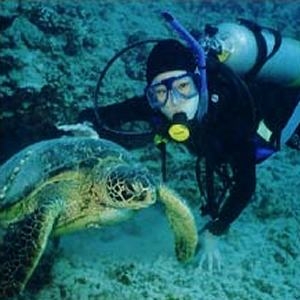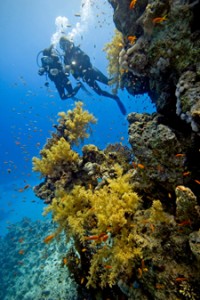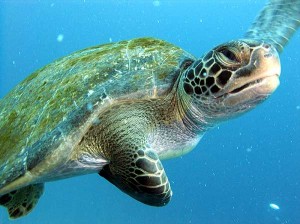Costa Rica Travel & Tourism News – Costa Rica is recognized world-wide as one of the most bio diverse nations. The small country is sandwiched between the Caribbean Sea and the Pacific Ocean, and is home to a number of ecosystems. However, Costa Rica’s biodiversity does not end at its coastline. The country is a top dive destination, particularly along its Pacific shores. Costa Rica’s crystalline waters are home to a dazzling array of sea life. On the Pacific side of the country, the majority of reefs are made of volcanic rock with coral formations built on top with a… Continue reading →
Costa Rica Travel & Tourism News – Costa Rica is recognized world-wide as one of the most bio diverse nations. The small country is sandwiched between the Caribbean Sea and the Pacific Ocean, and is home to a number of ecosystems. However, Costa Rica’s biodiversity does not end at its coastline. The country is a top dive destination, particularly along its Pacific shores.
 Costa Rica’s crystalline waters are home to a dazzling array of sea life. On the Pacific side of the country, the majority of reefs are made of volcanic rock with coral formations built on top with a depth ranging between 8 to 35 meters (25 – 115 feet).
Costa Rica’s crystalline waters are home to a dazzling array of sea life. On the Pacific side of the country, the majority of reefs are made of volcanic rock with coral formations built on top with a depth ranging between 8 to 35 meters (25 – 115 feet).
According to Bobby Jo of Diving Safaris http://costaricadiving.net located in Playa Hermosa Guanacaste, this area puts her in the center of the best diving in the region because the southern part of Costa Rica is very isolated, and not as easily accessible as the northern region. However on the south Caribbean side of the country, there is a large coral reef park that lures some hard core divers to brave the long trip to experience this reef. Here are the top 10 best dive sites in Costa Rica.
- Cocos Islands
Cocos Island, 300 miles off Costa Rica’s mainland, is a UNESCO World Heritage Site that is world renowned as a top diving destination, perhaps the best in Costa Rica. Both “Scuba Travel” and “The Guardian” list Cocos Island as one of the world’s best. The area possesses a rich undersea diversity and supports more than 25 endemic fish species, including the red-lipped batfish. Pelagic species such as marlin, sailfish and sharks are drawn to the area to feed and mate. Whales also use the Cocos Island seamount as a place to congregate and calve. Getting to Cocos Island National Marine Park requires a lengthy boat trip, so your best bet to see this stunning area is a live aboard a dive vessel.
- Caño Island
Caño Island is in Drake Bay on the northwest side of the wild Osa Peninsula, which “National Geographic” cites as one of the Earth’s most bio diverse regions. The intense wildlife is the reason that Scuba Adviser and several of the countrys top diver operators considers Caño to be one of Costa Rica’s best dive spots. Apart from large number of reef species that team the island’s shelves and reefs, you can expect to encounter bigger creatures such as manta rays, free swimming moray eels and sharks. Other marine species common to the area include turtles, orcas and dolphins as well as humpback and pilot whales. This area is relatively remote, so you may want to book a resort near the island, such as the Pirate Cove Hotel (piratecovecostarica.com), near Corcovado National Park. The hotel is a PADI International Resort Association member and runs its own dive operation that offers both lessons and SCUBA excursions.
- Catalina Islands
Guanacaste dive operators and “Scuba Travel” agree that the Catalina Islands are the best site in Northwestern Costa  Rica. The islands are highly regarded dive sites not only because of the large pelagic species found in the area, but also because of the islands’ unique underwater structures, such as arches, caves and vibrant coral. The islands are in the Gulf of Papagayo, just offshore of Playa Ocotal and Flamingo Beach. The Ocotal Beach Resort (ocotaldiving.com) is a fully equipped dive resort with boats that can get you out to the islands.
Rica. The islands are highly regarded dive sites not only because of the large pelagic species found in the area, but also because of the islands’ unique underwater structures, such as arches, caves and vibrant coral. The islands are in the Gulf of Papagayo, just offshore of Playa Ocotal and Flamingo Beach. The Ocotal Beach Resort (ocotaldiving.com) is a fully equipped dive resort with boats that can get you out to the islands.
- Bat Islands
If you’re hoping to see large shark species like bull, tiger and whale sharks, as well as manta, eagle and devil rays, the Bat Islands, or Islas Murciélago, are your best bet, according to “Bajo el Agua,” a Spanish diving newsletter. The Bat Islands are part of the Santa Rosa National Park, just off the Playas del Coco in Northwestern Costa Rica. The dive site is best for experienced divers as strong currents and deep water drop-offs exist in the dive locations. One of the Bat Islands’ sites is known as “The Big Scare” because of the large number of dangerous shark species that congregate in the area. Diving Safaris http://costaricadiving.net is a company that can arrange your diving experience from Playa Hermosa.
- Cahuita Reef
This is where the largest reef is located. The best time to visit, if you’re looking for good visibility, is from March to early May and from mid-August to mid-November. Not only can you get your PADI scuba diving certification but you can also practice skin diving, deep sea diving and snorkeling. You will find over 35 species of coral, more than 300 different types of mollusks, lobsters, 3 species of turtles and thousands of colorful fish like the French Angel, Isabelita and Queen Angel. The reef extends 500 meters out to sea.
- Tortuga Island/Tambor
 The volcanic rock reef is surrounded by crystalline waters and home of Angelfish, Porcupine fish, Morays, Needlefish, Spotted Eagle Rays and many more tropical beauties that will make it for you an extraordinary experience. The temperature of the water varies between 24 and 26 degrees Celsius (78°-82°) with a visibility ranging from 5 to 30 meters (16- 100 feet) depending on the season. Tortuga Island is famous for its excellent visibility and large variety of fish and corals.
The volcanic rock reef is surrounded by crystalline waters and home of Angelfish, Porcupine fish, Morays, Needlefish, Spotted Eagle Rays and many more tropical beauties that will make it for you an extraordinary experience. The temperature of the water varies between 24 and 26 degrees Celsius (78°-82°) with a visibility ranging from 5 to 30 meters (16- 100 feet) depending on the season. Tortuga Island is famous for its excellent visibility and large variety of fish and corals.
- Manuel Antonio
The Manuel Antonio coastline has several choices for diving spots. Depending on your skill, you can visit one of these many spots. The coastline has a variety of settings from; shallow depth of 10 feet to over 90 feet in depth, volcanic reef, rock reef, sandbar areas and underwater canyons. The marine life in the area includes: Angel fish, Trumpet fish, Barracuda, White tip sharks, Stingray, Moray eels, Puffer fish, Octopus, and in some areas, Lobster. The currents range from calm, to strong surges and offers lots of choices depending on the time of day and the divers skill. Even a less experienced diver will enjoy a scuba dive into shallow water with schools of fish surrounding them. A more experienced diver can even schedule a night dive depending on conditions.
- Gulf of Papagayo
The diving is great quoted an experienced diver who recently visited this region. The visibility was 30 to 40 ft. with the water temperature in July at 80 degrees. There is only boat diving, no real shore diving. All the local diving in the bay area is calm with little to no current. The sea creatures you may encounter include many beautiful species of oceanic fish, Harlequin shrimp, , Moorish Idols, Green sea turtles, Bottlenose dolphins, Scorpion fish, Green Moray, spotted Moray, Nudibranchs, Seahorses, King Angels, and perhaps even an octopus.
- Isla Uvita
Isla Uvita is also most famous for the first landing spot of Christopher Colombus, who anchored here in 1502 and gave Costa Rica its name, meaning rich coast after seeing native people wearing gold earrings. He mistakenly believed that a wealthy empire must lay inland, and many gold-chasers came to Costa Rica later, and were disappointed to find little oro (gold in Spanish).You may have heard about The Phoenix, which is a Costa Rica wreck dive off of Uvita. The Phoenix sank several years ago and now attracts both fish and divers. Isla Uvita is only accessible by boat, a twenty minute trip (one kilometer) from the mainland in Limon. There are no tourist facilities here. No hotels, no restaurants, and not even any water. Still, people camp out here occasionally although technically its not legal.
- Cabo Blanco Islands
Cabo Blanco Nature Reserve was the first National Park to be established in Costa Rica in 1963. There are 1250 hectares (3088.82 acres) of forest and many kilometers of dramatic coastline are home to hundreds of animal and plant species (including the white faced and howler monkeys and the long-tailed coati) and Cabo Blanco Reserve is one of the most popular tourist destinations on the Nicoya Peninsula. About 2 km from the reserve’s southern tip lays the Isla Cabo Blanco. Since the times of the Conquistadores it has been known as the “White Cape”, because encrusted guano covers the rocks in dry season. This sea bird sanctuary is inhabited by large numbers of brown pelicans, frigate birds, laughing gulls, common terns and Costa Rica’s biggest community of brown boobies. There are three known wrecks very near to Cabo Blanco and two of them are inside the protected reserve. The biggest and best is the Grand Ranger, originally commissioned as the U.S.S. Typhoon, a World War II ship transport. The second wreck within the park is a 150 year old boat of unknown name, found off Playa Cabo Blanco. The third is the Caroline Star, which is the only one of the three that you can visit, since its outside of the parks forbidden waters, located just north of Cabuya Island.
By Stacey Dunahay
